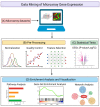Data Mining of Microarray Datasets in Translational Neuroscience
- PMID: 37759919
- PMCID: PMC10527016
- DOI: 10.3390/brainsci13091318
Data Mining of Microarray Datasets in Translational Neuroscience
Abstract
Data mining involves the computational analysis of a plethora of publicly available datasets to generate new hypotheses that can be further validated by experiments for the improved understanding of the pathogenesis of neurodegenerative diseases. Although the number of sequencing datasets is on the rise, microarray analysis conducted on diverse biological samples represent a large collection of datasets with multiple web-based programs that enable efficient and convenient data analysis. In this review, we first discuss the selection of biological samples associated with neurological disorders, and the possibility of a combination of datasets, from various types of samples, to conduct an integrated analysis in order to achieve a holistic understanding of the alterations in the examined biological system. We then summarize key approaches and studies that have made use of the data mining of microarray datasets to obtain insights into translational neuroscience applications, including biomarker discovery, therapeutic development, and the elucidation of the pathogenic mechanisms of neurodegenerative diseases. We further discuss the gap to be bridged between microarray and sequencing studies to improve the utilization and combination of different types of datasets, together with experimental validation, for more comprehensive analyses. We conclude by providing future perspectives on integrating multi-omics, to advance precision phenotyping and personalized medicine for neurodegenerative diseases.
Keywords: biological samples; biomarker discovery; circular RNA (circRNA); long non-coding RNA (lncRNA); messenger RNA (mRNA); microRNA (miRNA); microarray analysis; multi-omics integration; therapeutic development; translational neuroscience.
Conflict of interest statement
The authors declare no conflict of interest.
Figures


Similar articles
-
Integrative multi-omics and systems bioinformatics in translational neuroscience: A data mining perspective.J Pharm Anal. 2023 Aug;13(8):836-850. doi: 10.1016/j.jpha.2023.06.011. Epub 2023 Jun 30. J Pharm Anal. 2023. PMID: 37719197 Free PMC article. Review.
-
A Potential circRNA-miRNA-mRNA Regulatory Network in Asthmatic Airway Epithelial Cells Identified by Integrated Analysis of Microarray Datasets.Front Mol Biosci. 2021 Jul 16;8:703307. doi: 10.3389/fmolb.2021.703307. eCollection 2021. Front Mol Biosci. 2021. PMID: 34336929 Free PMC article.
-
A guide to multi-omics data collection and integration for translational medicine.Comput Struct Biotechnol J. 2022 Dec 1;21:134-149. doi: 10.1016/j.csbj.2022.11.050. eCollection 2023. Comput Struct Biotechnol J. 2022. PMID: 36544480 Free PMC article. Review.
-
Application of multi-omics techniques to androgenetic alopecia: Current status and perspectives.Comput Struct Biotechnol J. 2024 Jun 20;23:2623-2636. doi: 10.1016/j.csbj.2024.06.026. eCollection 2024 Dec. Comput Struct Biotechnol J. 2024. PMID: 39021583 Free PMC article. Review.
-
Multi-Omics Integration-Based Prioritisation of Competing Endogenous RNA Regulation Networks in Small Cell Lung Cancer: Molecular Characteristics and Drug Candidates.Front Oncol. 2022 Jul 4;12:904865. doi: 10.3389/fonc.2022.904865. eCollection 2022. Front Oncol. 2022. PMID: 35860558 Free PMC article.
Cited by
-
Role of metabolic dysfunction and inflammation along the liver-brain axis in animal models with obesity-induced neurodegeneration.Neural Regen Res. 2025 Apr 1;20(4):1069-1076. doi: 10.4103/NRR.NRR-D-23-01770. Epub 2024 May 17. Neural Regen Res. 2025. PMID: 38989938 Free PMC article.
-
Blood-Brain Barrier-Targeting Nanoparticles: Biomaterial Properties and Biomedical Applications in Translational Neuroscience.Pharmaceuticals (Basel). 2024 May 10;17(5):612. doi: 10.3390/ph17050612. Pharmaceuticals (Basel). 2024. PMID: 38794182 Free PMC article. Review.
-
Therapeutic targeting of obesity-induced neuroinflammation and neurodegeneration.Front Endocrinol (Lausanne). 2025 Jan 17;15:1456948. doi: 10.3389/fendo.2024.1456948. eCollection 2024. Front Endocrinol (Lausanne). 2025. PMID: 39897964 Free PMC article. Review.
-
Autolysosomal Dysfunction in Obesity-induced Metabolic Inflammation and Related Disorders.Curr Obes Rep. 2025 May 14;14(1):43. doi: 10.1007/s13679-025-00638-8. Curr Obes Rep. 2025. PMID: 40366502 Free PMC article. Review.
-
The Potential of Metabolomics to Find Proper Biomarkers for Addressing the Neuroprotective Efficacy of Drugs Aimed at Delaying Parkinson's and Alzheimer's Disease Progression.Cells. 2024 Jul 31;13(15):1288. doi: 10.3390/cells13151288. Cells. 2024. PMID: 39120318 Free PMC article. Review.
References
-
- Negi A., Shukla A., Jaiswar A., Shrinet J., Jasrotia R.S. In: Chapter 6-Applications and Challenges of Microarray and RNA-Sequencing. Singh D.B., Pathak R.K.B.T.-B., editors. Academic Press; Cambridge, MA, USA: 2022. pp. 91–103.
Publication types
Grants and funding
LinkOut - more resources
Full Text Sources
Miscellaneous

